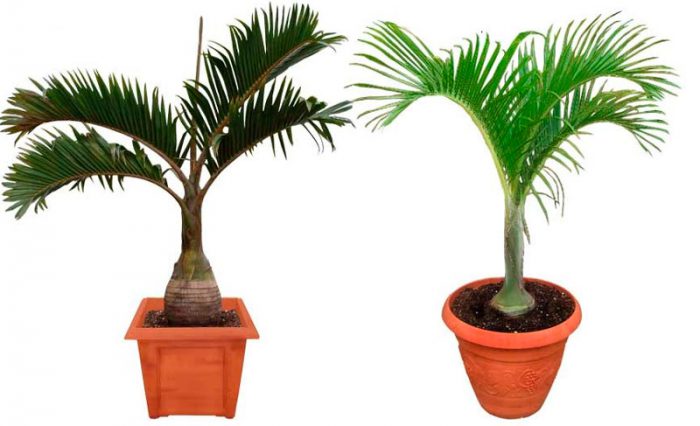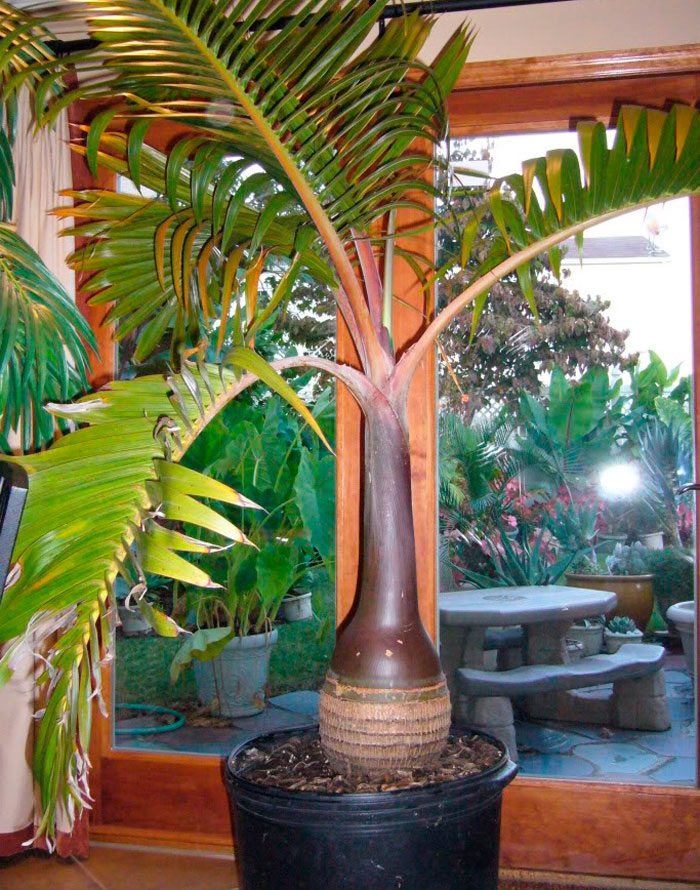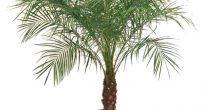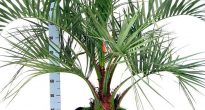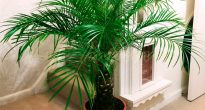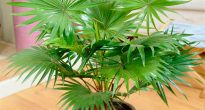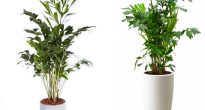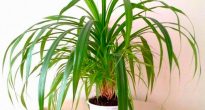An evergreen plant that is a perennial like gioforba (Hyophorbe) belongs to the palm or arec family (Arecaceae, Palmae). In nature, it can be found on the islands of the Indian Ocean.
This palm has a smooth trunk and a thickening in the middle. The foliage is feathery, fan-shaped.
Content
Gioforba care at home
Illumination
Bright lighting is necessary, but at the same time it should be diffused. It is best to place it near east or west windows. When placed on a south window, you need to shade from the direct rays of the sun.
Temperature regime
In summer, the plant will feel great at temperatures from 20 to 25 degrees, and in winter - at 16-18 degrees. Remember that the room should not be colder than 12 degrees. Such a plant needs fresh air throughout the year. However, it is necessary to ventilate carefully, since the palm tree reacts negatively to drafts.
Humidity
When humidity is high, the plant thrives. In this regard, daily spraying is recommended, and once or twice in 4 weeks, the leaves should be washed from dust with plain water. During cold wintering, foliage cannot be moistened.
How to water
Watering in spring and summer should be abundant. In this case, it is necessary to water after the top layer of the soil dries. Make sure that the soil in the pot does not dry out completely. In winter, watering is necessary less often. So, watering is carried out 2-3 days after the topsoil dries up. In winter, both overdrying of the soil and stagnation of liquid in it should not be allowed.
Top dressing
Top dressing is carried out from March to September 2 times a month. To do this, use a special fertilizer for palm trees.
Transplant features
This palm tree reacts extremely negatively to transplantation, therefore, for young specimens, it is carried out 1 time in 1-2 years. They use a transshipment method in order not to damage the root system. The transplant of adult specimens is carried out once every 4–5 years, but once a year it is necessary to change the topsoil to a new one. The soil mixture consists of leaf and sod land, as well as sand (2: 2: 1). You can take ready-made soil for palm trees for planting. Do not forget to make a good drainage layer at the bottom.
Breeding features
You can propagate by seeds. For their germination, a temperature of 25 to 35 degrees is needed. Sowing is carried out in pots filled with a mixture of moss or sand with sawdust.At the bottom of the container, a relatively thick drainage layer is made, while it is recommended to pour pieces of charcoal into it. After a couple of months, the first seedlings should appear. It is better to grow them in a mini-greenhouse at first, because they are very sensitive to changes in air humidity and drafts.
Diseases and pests
Can settle shield, spider mite.
Main types
Gioforba bottle-barreled (Hyophorbe lagenicaulis)
This palm tree grows very slowly and has a relatively short trunk (no more than 150 centimeters in height). The barrel has the shape of a bottle, while the diameter of the narrow part is 15 centimeters, and the wide one is 40 centimeters. The plumose leaf is 150 centimeters long. There are from 30 to 40 pairs of feathers that are 40 centimeters long and 5 centimeters wide. The petiole is pale red at the base and reaches 40 centimeters long. Under the crown of the foliage, in the narrow part of the trunk, there is an inflorescence that reaches 40 to 50 centimeters in length.
Gioforbe Verschaffelta (Hyophorbe verschaffeltii)
This palm tree also grows rather slowly, but it has a spindle-shaped trunk. In the middle, the grayish trunk has an expansion, and in height it can reach 8 meters. Green, tough, feathery leaves are 150 to 200 centimeters long. There are 30 to 50 pairs of feather leaves, which are 2–3 centimeters wide and 40 centimeters long. On the seamy surface there is a well-defined midrib. The short (6–7 cm) petiole has a yellowish stripe. A branched inflorescence, the length of which is 60–70 centimeters, is located in the expanded part of the trunk below the crown of the leaves. Fragrant flowers are small in size.

